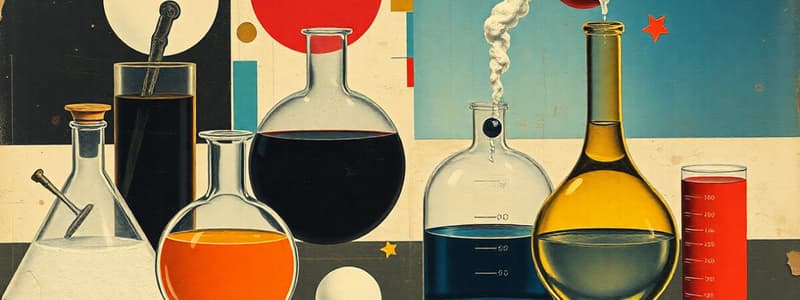Podcast
Questions and Answers
A chemist has samples of iron, water, and oxygen. Which of these correctly identifies a property shared by all three samples?
A chemist has samples of iron, water, and oxygen. Which of these correctly identifies a property shared by all three samples?
- They all have a definite shape.
- They all are easily compressible.
- They all have mass and occupy space. (correct)
- They all have a definite volume.
A student observes that a substance takes the shape of its container but maintains a constant volume. Which state of matter is the student most likely observing?
A student observes that a substance takes the shape of its container but maintains a constant volume. Which state of matter is the student most likely observing?
- Solid
- Gas
- Liquid (correct)
- Plasma
A sealed container is filled with a gas. If the volume of the container is decreased, what happens to the density of the gas inside?
A sealed container is filled with a gas. If the volume of the container is decreased, what happens to the density of the gas inside?
- The density remains the same.
- The change in density depends on the type of gas.
- The density decreases.
- The density increases. (correct)
Consider a balloon filled with air. Which statement best describes the motion of the air particles inside the balloon?
Consider a balloon filled with air. Which statement best describes the motion of the air particles inside the balloon?
A scientist is studying a substance with a very high density and a definite shape. Which arrangement of particles is most likely found in this substance?
A scientist is studying a substance with a very high density and a definite shape. Which arrangement of particles is most likely found in this substance?
Imagine two rooms, one filled with perfume and the other odorless. Which process explains how the scent of perfume eventually spreads throughout the odorless room?
Imagine two rooms, one filled with perfume and the other odorless. Which process explains how the scent of perfume eventually spreads throughout the odorless room?
When a metal rod is heated, its length increases slightly. Which of the following best explains this phenomenon?
When a metal rod is heated, its length increases slightly. Which of the following best explains this phenomenon?
A student is comparing the compressibility of different states of matter. Which of the following is the correct order of states of matter from most to least compressible?
A student is comparing the compressibility of different states of matter. Which of the following is the correct order of states of matter from most to least compressible?
If you increase the temperature of a liquid, what happens to the strength of the attractive forces between its particles?
If you increase the temperature of a liquid, what happens to the strength of the attractive forces between its particles?
A material is easily deformed under pressure but returns to its original shape when the pressure is released. Which property does this material exhibit?
A material is easily deformed under pressure but returns to its original shape when the pressure is released. Which property does this material exhibit?
A gas is heated in a closed, rigid container. What best explains the resulting increase in pressure within the container?
A gas is heated in a closed, rigid container. What best explains the resulting increase in pressure within the container?
A damp cloth dries faster on a sunny day compared to a cloudy day. Besides the sun's heat, what other factor significantly contributes to this faster drying process?
A damp cloth dries faster on a sunny day compared to a cloudy day. Besides the sun's heat, what other factor significantly contributes to this faster drying process?
Dry ice, or solid carbon dioxide, is often used to create a foggy effect. What property of dry ice allows it to create this effect?
Dry ice, or solid carbon dioxide, is often used to create a foggy effect. What property of dry ice allows it to create this effect?
When a candle burns, the wax melts due to the flame's heat. How does this phase change affect the movement and spacing of wax molecules?
When a candle burns, the wax melts due to the flame's heat. How does this phase change affect the movement and spacing of wax molecules?
When water freezes to form ice, why does the process release energy into the surroundings?
When water freezes to form ice, why does the process release energy into the surroundings?
On a hot day, an ice cream cone melts if not eaten quickly. How does the spacing between the particles in the ice cream change as it melts?
On a hot day, an ice cream cone melts if not eaten quickly. How does the spacing between the particles in the ice cream change as it melts?
Under specific atmospheric conditions, frost forms on surfaces when water vapor changes directly into solid ice. How is this phase transition classified?
Under specific atmospheric conditions, frost forms on surfaces when water vapor changes directly into solid ice. How is this phase transition classified?
Water is placed in a freezer and turns into ice. What happens to the average kinetic energy of the water molecules during freezing?
Water is placed in a freezer and turns into ice. What happens to the average kinetic energy of the water molecules during freezing?
A substance is heated, transitioning from solid to liquid and then to gas. How does its potential energy change during these phase transitions?
A substance is heated, transitioning from solid to liquid and then to gas. How does its potential energy change during these phase transitions?
Ice cream feels cold when melting in your mouth because of heat transfer. What describes this process most accurately?
Ice cream feels cold when melting in your mouth because of heat transfer. What describes this process most accurately?
Flashcards
Matter
Matter
Anything that occupies space and has mass.
States of Matter
States of Matter
Different forms in which matter can exist: solid, liquid, gas.
Diffusion in Gases
Diffusion in Gases
The spreading of particles in gases from high to low concentration.
Properties of Solids
Properties of Solids
Solids have a definite shape and volume, with closely packed particles.
Signup and view all the flashcards
Liquid Characteristics
Liquid Characteristics
Liquids have definite volume but take the shape of their container.
Signup and view all the flashcards
Gases Compressibility
Gases Compressibility
Gases can be easily compressed because their particles are far apart.
Signup and view all the flashcards
Elasticity
Elasticity
The ability of a material to return to its original shape after being deformed.
Signup and view all the flashcards
Particle Movement in Matter
Particle Movement in Matter
Particles in matter are in constant motion, influencing its state.
Signup and view all the flashcards
Attractive Forces in Liquids
Attractive Forces in Liquids
Attractive forces between liquid particles decrease when temperature rises.
Signup and view all the flashcards
Solid Arrangement of Particles
Solid Arrangement of Particles
In solids, particles are closely packed and vibrate in fixed positions.
Signup and view all the flashcards
Gases Shape and Volume
Gases Shape and Volume
Gases have widely spaced, moving particles, hence no definite shape and volume.
Signup and view all the flashcards
Evaporation
Evaporation
The process through which liquid turns into vapor, explained by drying wet clothes in the sun.
Signup and view all the flashcards
Sublimation
Sublimation
The phase change when a solid directly turns into a gas without becoming a liquid, like dry ice.
Signup and view all the flashcards
Melting
Melting
The phase change when a solid turns into a liquid, as seen in burning candle wax.
Signup and view all the flashcards
Freezing
Freezing
The phase change where a liquid turns into a solid, like water turning into ice.
Signup and view all the flashcards
Particle Movement in melting
Particle Movement in melting
During melting, particles of a substance move farther apart as it becomes a liquid.
Signup and view all the flashcards
Deposition
Deposition
The phase change when a gas turns into a solid without becoming a liquid, like dew on grass.
Signup and view all the flashcards
Kinetic Energy & Freezing
Kinetic Energy & Freezing
During freezing, the kinetic energy of particles decreases as they form a solid.
Signup and view all the flashcards
Heat Absorption in melting
Heat Absorption in melting
Melting ice cream absorbs heat from your tongue, making it feel cold.
Signup and view all the flashcards
Phase Changes & Temperature
Phase Changes & Temperature
As a substance heats up, particles move farther apart and can change state.
Signup and view all the flashcardsStudy Notes
Matter and its Properties
- Matter has weight, is a form of energy, and occupies space.
- States of matter include solid, liquid, gas, and plasma.
- Solids have a definite shape and volume.
- Liquids have a definite volume but take the shape of their container.
- Gases have neither a definite shape nor a definite volume, filling the container they're in.
Particle Arrangement in Matter
- Matter is made of tiny particles.
- Particles in solids are tightly packed and have fixed arrangements.
- Particles in liquids are close together but can move around.
- Particles in gases are far apart and move freely.
Properties of Solids
- Solids are rigid and maintain a definite shape.
- Particles in solids are closely packed and held together by strong bonds.
- Solids do not easily change shape.
Properties of Liquids
- Liquids take the shape of their container but maintain a relatively constant volume.
- Particles in liquids are close together but have the ability to move past one another.
- Liquids can flow.
Properties of Gases
- Gases take the shape and volume of their container.
- Particles in gases are far apart and move randomly at high speeds.
- Gases are easily compressed.
Diffusion
- Diffusion is the spreading of particles from a region of higher concentration to a region of lower concentration.
- Gases diffuse more easily than liquids or solids due to the greater separation of particles.
Changes of State
- Changes in temperature or pressure can cause a substance to change state (e.g., melting, freezing, vaporization, condensation, sublimation).
- Attractive forces between particles become weaker as temperature increases, allowing particles to move more freely.
- Substances can change from solid to gas directly (sublimation) and from gas to solid directly (deposition).
- The temperature of a substance can fluctuate during a phase change, but the particles remain the same.
Density
- Density is the mass per unit volume of a substance.
- Different substances have different densities.
Studying That Suits You
Use AI to generate personalized quizzes and flashcards to suit your learning preferences.




